
Palermo, 1173-1182; gold, filligree, pearls, jewels, cloisonné enamel
Capua, Cathedral Treasury
The Crucifiction decorates the centre of the bookcover. The figure of the dead Christ, His head lowered, is shown on a blue cross decorated with the sun and the moon; He is flanked by the Virgin and St John the Evangelist, with two angels flying above them. The corners of the outer-most frame are dominated by SS Peter, Paul, Philipp and Simon. In the upper centre stands a plate-bearing archangel, at the bottom centre is St Agatha, while on the sides are depicted Sts Andrew, Jacob, Thaddaeus, and Thomas. All figures are identified by inscriptions in Latin script.

southern Italy, Norman (?) 11th/12th century
bronze (copper alloy), h. 84,5 cm, l. 86,4 cm, w. 33 cm
on loan to the Metropolitan Museum of Art, New York
This impressive bronze lion is one of the largest sculptures in the round to have survived from the Middle Ages. The lion was probably once gilded and decorated around the mouth with inlays though we can no longer identify the materials used. The animals's body contains a vessel. It has been suggested that it contained a kind of hydraulic system that served as a fountain fitting. We know that figures of lions - as automata or to decorate fountains - were luxury toys that were fashionable at the Byzantine court, in the Muslim world and in the West.
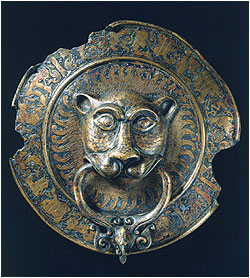
Cast bronze, engraved, niello, diam. 44,3 cm
Copenhagen, Davids Samling
The face of this lion looks very human with its bushy eye-brows and big, broad nose. The effect of the large almond-shaped eyes with pupils and iris made of engraved spirals twisting in opposite directions is unusual - they create the impression that the lion is staring with an intense, almost hypnotic gaze. The head's function (to knock on doors) counters the suggestion that it may have come from a mosk. Instead all evidence points to the conclusion that it was made for use on a secular building.

Southern Italy, 1st half of the 13th century; setting: Vienna, middle of the 18th century
Rock crystal, h. 40,5 cm, diam. 31 cm;
Vienna, Kunsthistorisches Museum
This exceptional vessel is the largest monolithic rock crystal vase, unique not only among vessels that have survived from the Middle Ages. It holds 8,75 litres. Vessels of such dimensions are only known from despcriptions of the Fatimid treasuries which contained a smooth rock-crystal jug that held nine litres. Between 1061 and 1069 the treasury of Khalif al-Mustansir was pillaged and its treasures dispersed throughout the countries bordering on the Mediteranean. One of these old ewers may have inspired the princely patron of this ewer not to have the large rock crystal cut up but to atempt something similar.

Southern Italy, 12th century (?)
Rock crystal, h. 27,8 cm, w. ca. 21 cm, d. 16,2 cm
private collection
This pear-shaped, twelve-facetted ewer is cut from a single piece of rock crystal with very few inclusions. In relation to the body, the base is very small and the mouth wide. A short neck surmounts three pointed rings of equal width that do not interrupt the facetting. The unusual shape of the broad handle is unique. It is the second-largest extant ewer in the world and probably originated in 12th century Norman Sicily. Its original setting denotes a royal patron.
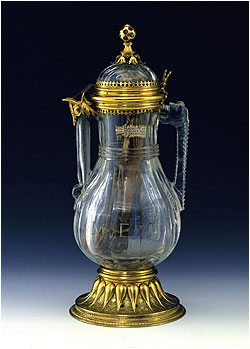
Sicily (?), 12th century; setting: 1487-1492
Rock crystal, gilded silver, enamel, h. 37,3 cm; rock crystal ewer: h. c. 21 cm, diam. 13,7 cm
Florence, Tesoro di San Lorenzo
This elegant, pear-shaped ewer with twelve facets is unusual because of its round, vertical spout connected to the neck by a bridge, and its handle. The precisely cut lid was probably executed at a later date when the ewer was turned into a reliquary. The stylised head of a lion with open mouth forms the short horizontal arm of the rectangular handle. The beast's mane covers the long vertical arm - executed as horizontal grooves on the inside of the handle and as angled lines on the outside.
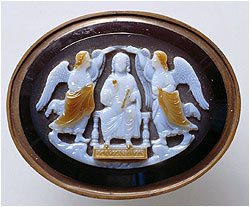
Southern Italy, 1st quarter of the 13th century
Three-layered sardonyx, 4,7 x 5,7 cm, setting: gilded copper
Munich, Staatliche Münzsammlung
The beardless youthful ruler is facing the spectator in a rigidly frontal pose seated on a throne; with his right hand he holds a sphere (orb) before his chest, while his left grasps a short sceptre. His shod feet are placed symetrically on a thick base (footstool). He is flanked by two winged victory goddesses (?) depicted in profile, who support a wreath above his head as though about to crown him. They are standing on a rocky strip of earth that continues beneath the base of the throne.

Southern Italy, 2nd quarter of the 13th century; thin modern setting
Three-layered sardonyx, 5,4 x 6,5 cm
St. Petersburg, Hermitage
Depicted here is the moment in which Joseph reveals himself to his brothers. Joseph had hidden a silver cup in Benjamin's sack of corn and had accused the brothers of having stolen it. Now they have returned to him to offer themselves as slaves to Joseph whom they still do not recognise as their own brother. However, he sends them away saying "Return in peace to your father" (Gen. 44,17), intending to keep only Benjamin. But Juda falls to his knees and offers himself as a slave because their father would not survive the loss of Benjamin. Moved by this, Joseph reveals himself.

Egypt, 12th/13th century
Ivory with wood, black mastix, gilded bronze, 39 x 40 x 23,5 cm
Palermo, Treasury of the Cappella Palatina
Nothing comparable to this box-like container has survived in any of the countries bordering on the Mediteranean. The Arab inscription engraved in Naski script celebrates beauty and tells us that the box was used to house jewels, and perhaps also important documents and securities. The barrel-like lid is rare, not to say unusual in Islamic art. However, the decoration consisting of concentric double-circles enclosing various depictions is typical of Islamic iconography, particularly in Egyptian art.

Palermo, c. 1220/1222
Gold, gilded silver, enamel, pearls, jewels
Palermo, Treasury of the Cathedral
The present form of the crown is the result of an arbitrary 19th century reconstruction. The original material probably came into contact with the polished metal and the latter's oxidation damaged the fabric. Disintegrating fragments of fabric were removed; in the 14th century those pieces of fabric that could be reused were strengthened, in the 19th century they were replaced by a new, semi-firm support for the calotte. The pearls were also re-strung which was made necessary by the removal of the material to which they were attached.
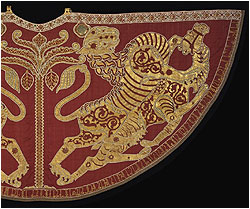
Palermo, 1133/34
Samite, gold- and silk embroidery, pearls, gold, cloisonné enamel, jewels
h: 146 cm, w: 345 cm
Vienna, Kunsthistorisches Museum
This precious coronation mantle was made of samite (incised silk) for King Roger II of Sicily. Decoration and images originate in the Ancient Orient ande were loaned from Arab art: two symetrically arranged lions thriumph over a camel; they flank a stylised palm tree in the shape of a tree of life. The lions symbolise the ruler who vanquishes his enemies. The mantle was so precious that these "foreign" images were overlooked and it became the coronation mantle of the kings and emperors of the Holy Roman Empire since the 13th century.
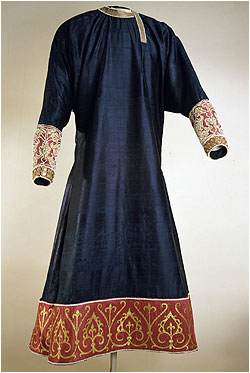
Palermo, 2nd quarter of the 12th century
Blue and red velvet, gold embroidery, gold appliqués with cloisonné enamel and filligree, pearls; l. 141,5 cm, 343 cm wide at hem
Vienna, Kunsthistorisches Museum
The embroidery on the cuffs of the sleeve of the Tunicella, which was worn under the Alba, is unusual. Rows of pearls form palmettes that are decorated with small threaded tubes of gold. After application, these fragile tubes were flattened, and some are lost. This unusual decoration has so far remained unique. The neck is framed by three centimetres wide tablet weave, which is itself framed by indiidually applied pearls. t is similart to the decoration used on the Alba.

Palermo, 1181, with later additions; silk, gold wire embroidery, pearls, emeralds, saphires, amethysts, spinells, garnets, opals
154 cm long, 127 cm wide at the hem
Vienna, Kunsthistorisches Museum
This precious silk robe was worn at by the kings and emperors of the Holy Roman Empire at their coronation. Thebottom edges of the wide hem are decorated with Latin and Arab inscriptions that tell us that the Alba was made for King William II (1153/1166-1189) in 1181 in Palermo. In 1194 Alba, blue Tunicella and the Coronation Mantle were inherited togther with the rest of the treausures of the Norman Kings of Sicily by the Hohenstaufen, and thus by the Holy Roman Empire. The Alba - unlike the lithurgical alba - was originally a royal outer garment.

Palermo, 1149
Tombstone: white marble with opus sectile inlays in red porphyry, green Brescia serpentin, white marble and glass tesserae in gold, red and yellow, 40 x 32 cm
On August 20, 1148 Anne, the mother of Grisandus, King Roger's chaplain, died. She was buried in the cathedral in Palermo where her tomb is marked by a simple Latin epigraph. Later Grisandus errected a fuerary chapel for his mother in the church of San Michele Archangelo. On May 20, 1149 he moved her remains from the cathedral to the new chapel. Her new tomb was decorared by this "quatro-lingual" tombstone and an epitaph in Latin verse.